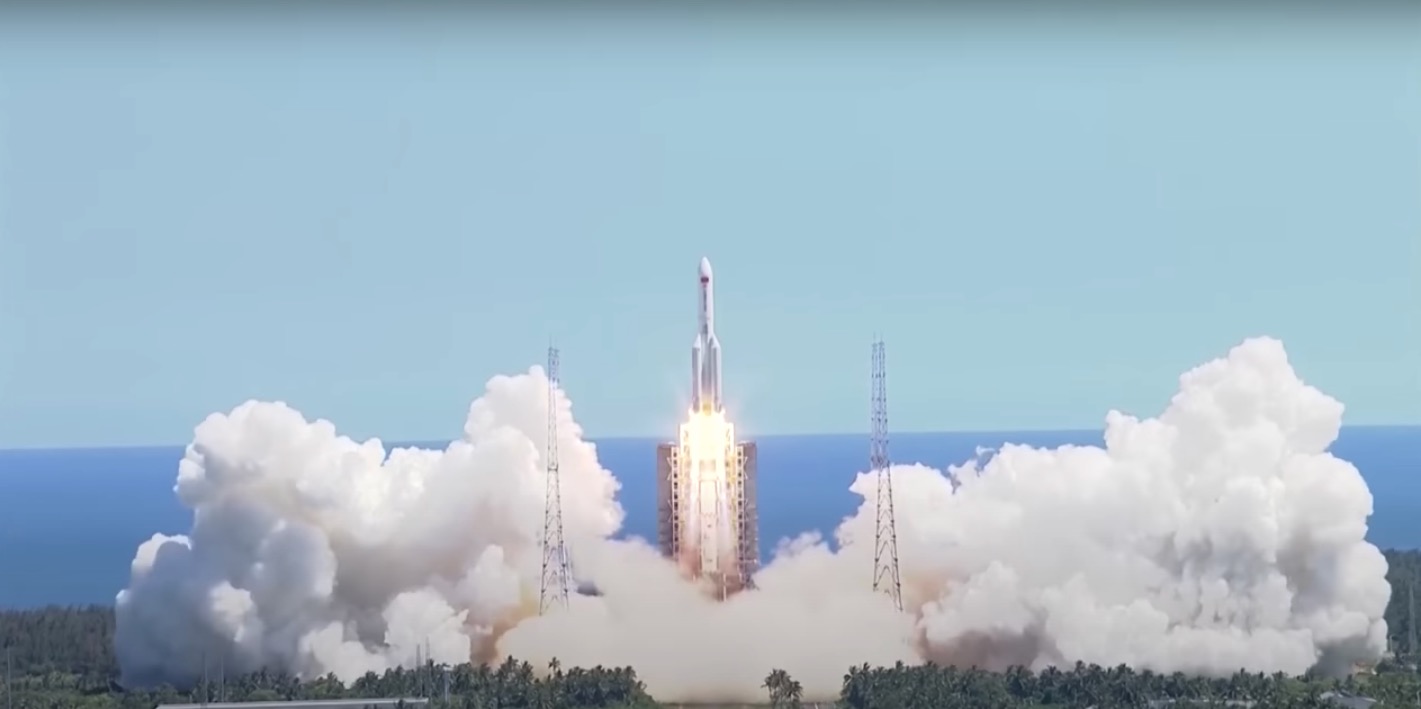See China's huge uncontrolled rocket debris fall from space in fiery skywatcher videos

A huge Chinese rocket fell back to Earth this weekend in a dazzling (if fiery) display as it broke apart during reentry as it plunged from space over the Indian Ocean.
The rocket, a 25-ton booster for China's most powerful rocket the Long March 5B, reentered Earth's atmosphere Saturday (July 30) after launching the country's new Wentian module to its Tiangong space station on July 24. Some stargazers managed to capture videos of the massive rocket's reentry and shared them on social media.
Related: The biggest spacecraft to fall uncontrolled from space
meteor spotted in kuching! #jalanbako 31/7/2022 pic.twitter.com/ff8b2zI2swJuly 30, 2022
The most striking video comes from Twitter user Nazri Sulaiman, who captured a 27-second video from Kuching, Malaysia of what appears to the Long March 5B rocket stage as it broke apart. The video shows one section of the object outshining others as it was trailed by a trail of fiery debris.
"Meteor spotted in Kuching!" Sulaiman wrote with in an initial post. "Sorry, it's not a meteor. It's the rocket. My bad." they added later while sharing a series of photos of the reentry.
🚀🚀 to the moon 🚀🚀 pic.twitter.com/fleq6ViLdWJuly 30, 2022
Another Twitter user, @HanifDaspepzz, captured a similar view from Kuching, showing debris streaking across the sky high over an ornate rooftop as the rocket stage burned up.
Kuching Sarawak.. meteor or apa pic.twitter.com/HJzN1zbOJ6July 30, 2022
One video from Lampung, Indonesia, released on Instagram from the Lampung Geh! News, shows what appears to be an early phase of the reentry when the Long March 5B rocket stage was largely intact, according to Marco Langbroek, a veteran satellite tracker.
Breaking space news, the latest updates on rocket launches, skywatching events and more!
A post shared by Lampung Geh News (@lampunggehnews)
A photo posted by on
A couple of other skywatchers, including Twitter user @Exad00 and Haiqal Iskandar of the state of Sarawak in Malaysia, captured views as well.
Objek seperti tahi bintang kelihatan di langit beberapa kawasan di seluruh Sarawak sekitar jam 12.50 malam tadi.Kredit : Haiqal Iskandar pic.twitter.com/mCfe8Uy4xdJuly 30, 2022
Komet?@RoyalAstroSoc @akademisains pic.twitter.com/IgEh42dYmCJuly 30, 2022
Officials with the China Manned Spaceflight Engineering office said in a Weibo statement that the reentry occurred at 119.0 degrees east longitude and 9.1 degrees north latitude, a location over open ocean, just off the coast of Palawan Island, in the Philippines.
Between 5.5 tons and 9.9 tons (5 to 9 metric tons) of debris from China's Long March 5B rocket stage was expected to survive the reentry to reach the Earth, according to experts with The Aerospace Corporation Center for Orbital Reentry and Debris Studies. It is the third time China has intentionally allowed a Long March 5B, the country's biggest rocket, to fall uncontrolled from space after launch in recent years, a practice critics have criticized as reckless.
NASA Administrator Bill Nelson complained in a statement Saturday that the China National Space Administration did not share trajectory information on the falling Long March 5B as it returned to Earth.
"All spacefaring nations should follow established best practices, and do their part to share this type of information in advance to allow reliable predictions of potential debris impact risk, especially for heavy-lift vehicles, like the Long March 5B, which carry a significant risk of loss of life and property," Nelson said. "Doing so is critical to the responsible use of space and to ensure the safety of people here on Earth."
Email Tariq Malik at tmalik@space.com or follow him @tariqjmalik. Follow us @Spacedotcom, Facebook and Instagram.

Tariq is the award-winning Editor-in-Chief of Space.com and joined the team in 2001. He covers human spaceflight, as well as skywatching and entertainment. He became Space.com's Editor-in-Chief in 2019. Before joining Space.com, Tariq was a staff reporter for The Los Angeles Times covering education and city beats in La Habra, Fullerton and Huntington Beach. He's a recipient of the 2022 Harry Kolcum Award for excellence in space reporting and the 2025 Space Pioneer Award from the National Space Society. He is an Eagle Scout and Space Camp alum with journalism degrees from the USC and NYU. You can find Tariq at Space.com and as the co-host to the This Week In Space podcast on the TWiT network. To see his latest project, you can follow Tariq on Twitter @tariqjmalik.
